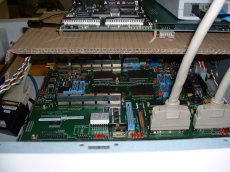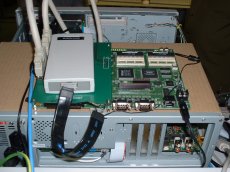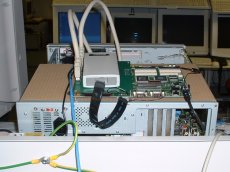A few weeks ago we visited PowerVR for a meeting with David Harold and John Metcalfe to check up on the progress of PowerVR's 3D graphics solution for small devices, MBX. Before sitting down and chatting with John we took a look at a development MBX system, as seen below.
The images above are of an MBX development emulation system based on the Hitachi SH4 processor. The system was fully operational as MBX would, and was running 3D demos, however the performance was roughly 10 times slower than they expected real MBX empowered processors to be (which may give their demo group a bit more work to do when real processors become available!).
The system here was running a car dashboard type display, which is one of the potential applications that MBX could take. A 3D city map demo, whereby you can actually fly down into the city, rather than the straight top down map views normal car navigation systems have, was also displayed, which could give navigation systems a more realistic representation of the city you are in and hence give appropriate direction from a driver eye view.
Once we had a look at the development system set sat down and had a chat about MBX and also gleaned a small update on PowerVR Series 5.
From MBX Lite to the full MBX specification, where do you see the range of devices they might be applicable to?
MBX Lite will initially be going into premium phones, but actually we expect that to move down a segment fairly quickly. With MBX bear in mind that the licensee can control the clock speed. So, dependant on that, at the high end you will get dedicated handheld gaming, set top boxes with 3D graphics capabilities and in-car systems for entertainment and navigation.
At the top end, the easiest way of looking at it is resolution and with MBX the highest sensible display resolution is 1024x768.




